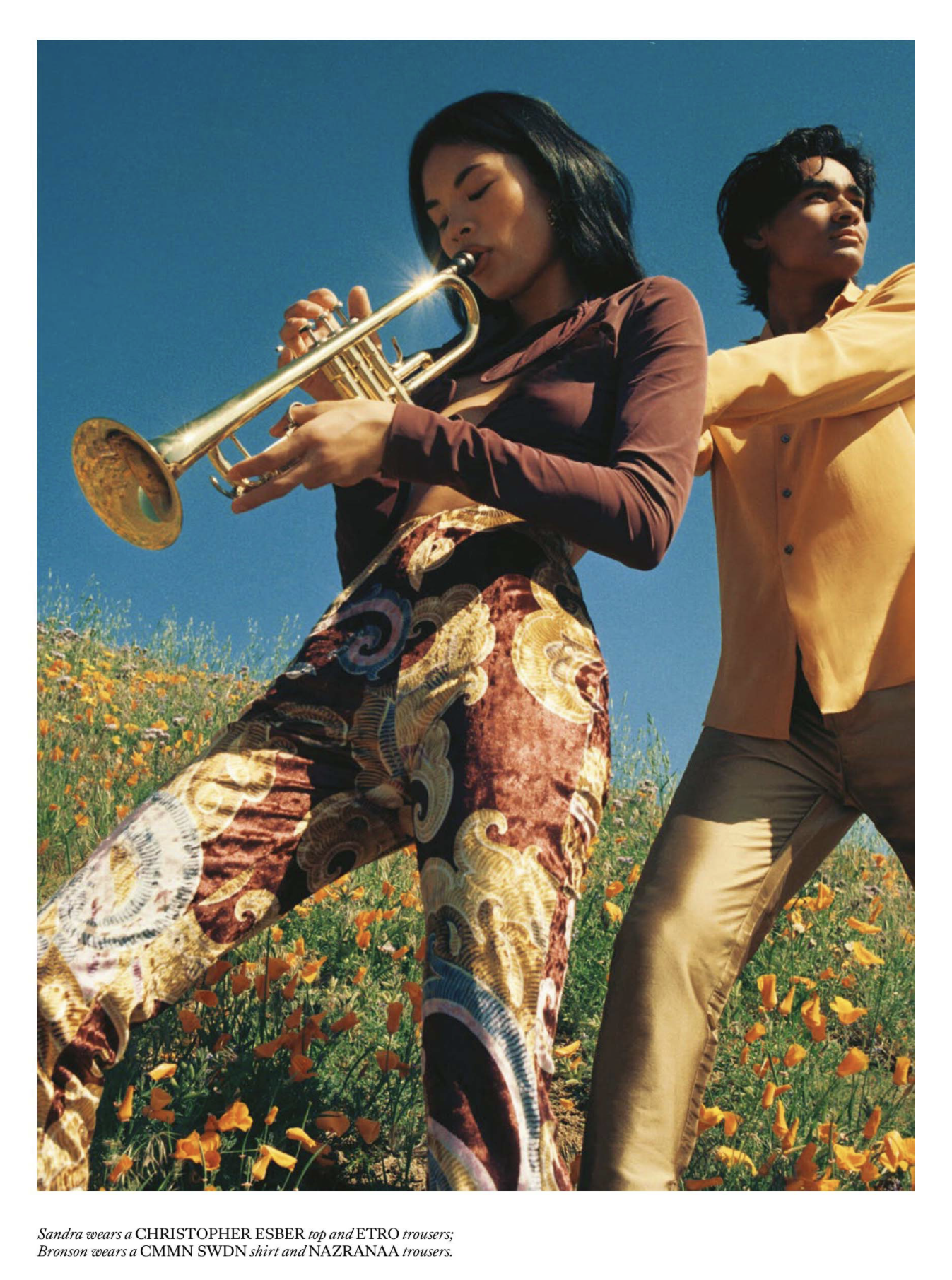Vogue Philippines Explores Wanderlust and AOC Erupts with Discovery of DRD4-7R Gene
/The July-August 2025 issue of Vogue Philippines [IG] feeds our wanderlust desire, a trait not experienced by all humans in the same way.
As always, AOC is on the hunt for new discovery and we found a lollapalooza-size surprise. There is a probable link between wanderlust and the DRD4-7R gene variant. Who knew?
In the fashion story ‘Brighter Days’, models Sandra Drifter, Brett Prendergast and Bronson Garel explore the fields of California, styled by Soaree Choen in vintage, Gucci, Kaiane Designs, Marni, Ronny Kobo, The Row and more.
Clearly, the terrain at Elizabeth Lake in the Sierra Pelona Mountains — pictured here — helped to create images awash in wildflowers, draped in sun-washed silks, retro tailoring, and a warm haze of memory captured eloquently in images by Charles Lu [IG]. / Makeup by Monique Mazer; hair by Terri Walker
Read MoreMonica Bellucci's Languid, Sensual Summer Style in Marie Claire France August 2025
/It’s sensual ladies day on AOC, and of course Monica Bellucci enters stage left in her cover story for Marie Claire France [IG] August 2025. Jeanne Le Bault styled Bellucci in Ann Demeulemeester, Eres, Gucci, Intimissimi, Isabel Marant, Mango, Notshy, Saint Laurent by Anthony Vaccarello. Photographer Fred Meylan [IG] captures the eternally beautiful film star and Cartier ambassador wearing only Cartier in the photo shoot. / Hair by John Nollet; makeup by Letizia Carnevale
Read MoreActor Eva Mendes Embraces a Sensual Life | What Might Neuroimaging Her Brain Reveal?
/Actor Eva Mendes Embraces a Sensual Life | What Might Neuroimaging Her Brain Reveal?
Actor, activist, wife of Ryan Gosling and mom to their two daughters, Eva Mendes is a fabulously sensual woman. Much of American culture would call her a sex bomb.
Eva Mendes also calls herself a sex bomb, highly influenced by her husband’s deep appreciation for her sex appeal.
I asked AI to explain how neuroimaging would differentiate brain activity in a person who particularly enjoys fragrant flowers, dancing, and swimming with heightened awareness and intense pleasure. Someone like Eva Mendes.
AOC has been a huge fan of brain science for years because our brains are truthful when different regions are activited.
The basic idea I want to communicate is that our brains are a fingerprint of sorts of who we are. In the case of Eva Mendes, I promise you that she has highly-elevated SPS, as defined in point 4.
She also has elevated Openness to Experience, as defined in my Louis Vuitton analysis from Monday, see final notes in article link.
Read MoreLouis Vuitton FW25 Offers Express Bag for High Speed, High Performance, High Self-Expectations Lives
/Louis Vuitton FW25 Offers Express Bag for High Speed, High Performance, High Self-Expectations Lives
Louis Vuitton Women taps House Ambassadors Emma Stone and Hoyeon Jung for the Fall/Winter 2025 Campaign, lensed by Ethan James Green.
Before Speedy Came Express
Bags and luggage are the visual currency of the Louis Vuitton brand. They also ring the cash register at critical levels to support LV’s position in the LVMH heirarchy. The FW25 Campaign is focused on its latest handbag: the Express, a roomy reprise of the original name of Vuitton’s signature Speedy handbag.
Louis Vuitton’s Chairman and CEO Pietro Beccari delivered press comments detailing the important role ‘The Louis’ marks on the new journey the luxury brand is taking into the DNA of Louis Vuitton itself. Reinforcing key buzzwords, Beccari stressed the importance of Louis Vuitton’s spirit of travel being experienced not only by crossing national borders, “but through ideas, emotions and inspiration.”
Anne drills down on exactly what Beccari’s words mean.
Read MoreJean Campbell's Pain Control Advocacy in ELLE UK | AOC Updates the Breakthroughs
/Jean Campbell's Pain Control Advocacy in ELLE UK | AOC Updates the Breakthroughs
Scottish-born beauty and top model Jean Campbell previews lingerie-inspired lace and leather mixes, accessorized with big gold jewelry in true 1980s spirit, lensed by Ekua King [IG] for the March 2025 issue of British ELLE.
Clementina Jackson chats with Lady Campbell, revisiting the topic of pain in her life and the podcast ‘I’m Fine’ she created to talk about it.
In her podcast, Jean Campbell talks to people about their own experiences with pain management, while sharing information about new research and test results in the field. Following her lead, AOC takes a look at the latest breakthroughs in learning to embrace chronic pain while not letting it define us.
The Patient Assumes New Powers in Non-Opioid Pain Management
In recent years, the focus on non-opioid pain management alternatives has gained significant attention as healthcare providers strive to mitigate the risks associated with opioid use, such as addiction and overdose. This shift has led to the exploration and adoption of various innovative strategies and treatments aimed at effectively managing pain without the reliance on opioid medications. One of the most promising alternatives includes the use of nonsteroidal anti-inflammatory drugs [NSAIDs], which are commonly prescribed to reduce inflammation and relieve pain without the addictive properties of opioids.
On February 4, 2025, CNN’s Dr. Sanjay Gupta spoke about the U.S Food and Drug Administration [FDA] approval of Journavx, or suzetrigine, oral tablets. “These pain medications, suzetrigine, Journavx as it’s called, work . . . more at the location of the pain, . . . trying to block the signals coming from the source of pain, going to the brain. As a result, you shouldn’t get euphoria,” Dr. Gupta explained. And, what is so critical about this breakthrough, is its lack of addictive ingredients.
Read MoreMore or Less Issue 8: What Our Love of Plants and Flowers Tells Us About Our Politics
/More or Less Issue 8: What Our Love of Plants and Flowers Tells Us About Our Politics
Photographer Carlijn Jacobs [IG] captures models Sascha Rajasulu and Yasmin Wijnaldumwalks in the natural world of ancestral traditions and conscious consumption for More or Less Magazine’s [IG] Issue 8.
In the Beginning . . . .
The first definitive evidence of flowers traces back to the Cretaceous period, around 130 million years ago, during a time when the Earth's climate and landscapes were undergoing significant change.
Prior to this floral revolution, vegetation was dominated by gymnosperms, ferns, and mosses. The advent of flowers introduced a new mechanism for pollination, often involving intricate interactions with the animal kingdom, particularly insects.
Human-Plant Interaction Studies Using Brain Science
Fast forward to now and human-invented technologies that explore these human-plant interactions. Modern-day researchers strive to understand the psychological and neurological impacts of plants on humans — including our brains.
Read MoreOur Brains Love Swimming, So Grab a New Zara Swimsuit and Take the Plunge in June
/Our Brains Love Swimming, So Grab a New Zara Swimsuit and Take the Plunge in June
Zara drops another swimwear capsule, this time a June 2023 collection modeled by Steffi Cook, shot by Kate Bellm [IG]./ Hair by Karim Belghiran; makeup by Jose Carlos Gonzalez
Your Body and Brain Love Swimming
Swimming is often considered one of the best exercises for the body, but did you know that it can also have major benefits for the brain? Research has shown that swimming can positively impact various aspects of the brain, including cognitive function, memory, and even mood.
Firstly, swimming is known to stimulate the growth of new brain cells, a process known as neurogenesis. This is especially important as we age, as the creation of new brain cells slows down over time. Swimming can help boost this process, especially in the hippocampus, an area of the brain responsible for memory and learning.
Read MoreOn Earth Mike Pompeo Says US Schools Teach Filth As Artemis 1 Flies 81 Miles From Moon
/Republican 2024 presidential wannabe Mike Pompeo called Randi Weingarten, president of the American Federation of Teachers and a member of the AFL–CIO, “the most dangerous person in the world.”
If you ask, “Who’s the most likely to take this republic down?” It would be the teacher’s unions, and the filth that they’re teaching our kids, and the fact that they don’t know math and reading or writing.
Note the use of the word ‘filth’ in referring to America’s school curriculums. That word really got my attention because it’s one deeply associated — actually programmed into our brains — with our political views.
Read MoreMalika El Maslouhi Holiday Moves by Giampaolo Sgura for Sunday Times Style UK
/Model Malika El Maslouhi puts some serious energy into the weekend’s Sunday Times Style Magazine UK cover story featuring ‘Bring it on!’ . The spirit is joy and movement with a focus on “272 luxury gifts you’ll really, really want.” Verity Parker styles El Maslouhi in bold-colors clothes lensed by Giampaolo Sgura [IG]. /Executive producer Leila Hartley; hair by Franco Gobbi; makeup by Cosetta Giorgietti
El Maslouhi’s poses reminds us that scientific evidence is mounting around the ways that moving our bodies changes our brains and helps enormously with stress management, both short-term and long. If joy is in fashion’s current mindset, the science around possessions and well-being or happiness remains murky. In fact, science delineates between well-being and happiness, on the topic of material wealth.
The reasons why body movement and exercise improve brain health and positivity are not definitely clear either. But all science agrees that movement is attached to joy and a positive mental outlook, whether resulting from stress management, that elusive endorphin-rush you read about or both.










